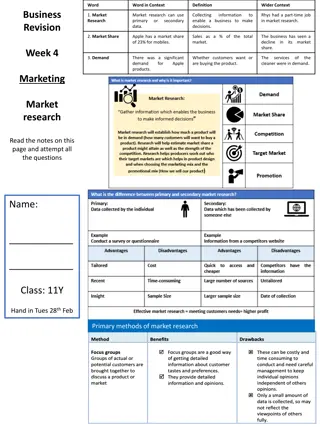International Market Entry Strategies Overview
As trade barriers diminish globally, companies must formulate effective strategies to enter international markets. The choice of foreign market entry strategy depends on risk levels, resource commitment, and return on investment. Various strategies such as export-import trade, turn-key projects, foreign direct investment, franchising, and management contracts are explored. The overview also delves into government controls on international trade, including tariffs and non-tariff barriers, emphasizing reasons governments impose tariffs.
Uploaded on Aug 03, 2024 | 0 Views
Download Presentation

Please find below an Image/Link to download the presentation.
The content on the website is provided AS IS for your information and personal use only. It may not be sold, licensed, or shared on other websites without obtaining consent from the author.If you encounter any issues during the download, it is possible that the publisher has removed the file from their server.
You are allowed to download the files provided on this website for personal or commercial use, subject to the condition that they are used lawfully. All files are the property of their respective owners.
The content on the website is provided AS IS for your information and personal use only. It may not be sold, licensed, or shared on other websites without obtaining consent from the author.
E N D
Presentation Transcript
CHAPTER 2 International Market Entry Strategies
Introduction Trade barriers are falling around the world Companies need to have a strategy to enter world markets.
How Do Firms Go International? Foreign market entry strategies vary in: Degree of risk they present, The control and commitment of resources they require, and The return on investment they promise.
Which strategy should be used? It depends on: Vision Attitude toward risk How much investment capital is available How much control is desired
6 Foreign market entry strategies Export-import trade Turn-key Projects Entry Strategies Foreign direct investment Franchising Management contracts
1. Export and import Exporting : Shipment of goods or services out of the port of a country , to a foreign buyer. Importing : Process of buying goods from a foreign supplier and entering them into the a different country.
Government controls over international trade Restrictions on imports generally take two forms: tariffs ,and quantitative restrictions (Quota). A. Tariffs: Import taxes imposed on goods entering the customs zone of a nation. Tariffs restrict or discourage imports by making imported goods more expensive than domestic goods. Tariffs vary widely from country to country and from product to product within countries.
Why do governments impose tariffs? 1. Tariffs provide a significant source of government revenues. 2. Protection of domestic industry. 3. Political reasons: Countries wishing to punish or influence the behavior of another country for human rights violations, for example, will sometimes restrict imports from misbehaving country.
Government controls over international trade B. Non-tariff Barriers: All barriers to importing or exporting other than tariffs ,ex. Quota. Quota: restriction imposed by law on the numbers or quantities of goods or of a particular type of good.
2. Foreign Direct Investment (FDI) Foreign direct investment (FDI) happens when a firm invests directly in new facilities to produce and/or market in a foreign country. Example : Starbuck purchases an existing UK firm, British Coffee, to sell coffee, tea and desserts in the UK.
Indirect investments Direct investments are when companies make physical investments and purchases in buildings, factories, machines, and other equipment outside of their home country. Indirect investments are when companies or financial institutions purchase shares in companies on a foreign stock exchange. No managerial involvement = portfolio investment (Indirect Investment).
2. Foreign Direct Investment (FDI) FDI Involves ownership of unit abroad for: Production Marketing/service R&D Raw materials or other resource access Parent company has direct managerial control. The degree of direct managerial control depends on the extent of ownership of the foreign entity and on other contractual terms of the FDI.
Forms of FDI 1. Purchase of existing assets: Quick entry, local market know-how, local financing may be possible, Eliminate competitor, Buying problems.
Forms of FDI 2. New investment : No local entity exists or is available for sale, local financial incentives may encourage, No inherited problems, long lead time to generation of sales or other desired outcome. 3. Participation in an international joint-venture: Shared ownership with local and/or other non- local partner.
3. Franchising Franchising: Franchising is a form of business in which a firm that already has a successful product or service (franchisor) licenses its trademark and method of doing business to another business or individual (franchisee) in exchange for a franchise fee and an ongoing regular payments.
FranchisorFranchisee relationship Regulated by contract which usually covers: Initial fee. Royalty fee/Management fee. Capital required from franchisee. Area of operation. Duration of license and renewal Termination (End).
4. Management contracts A management contract: is an arrangement under which operational functions of a company is assigned by contract to another company which performs the necessary managerial functions in return for a fee. Management contracts involve not just selling a method of doing things but involve actually doing them. A management contract can involve a wide range of functions, such as management of personnel, accounting, marketing services and training.
Management Contracts- Examples Sports Facility Managers Property Management Artist Managers
5. Turn-key Projects Turn-key project : is a type of project that is constructed by a developer and sold or turned over to a buyer in a ready-to-use condition. Contractor agrees to handle every detail of project for the foreign client. Turnkey projects are also used in government owned housing projects; an outside developer does all the work to build the housing units, and furnishing them with appliances. They then turned over to the government.
6. Contract Manufacturing Contract Manufacturing: A firm producing goods under the brand name of a different firm. In the computer and electronics fields, thousands of products are manufactured by contract manufacturers. These products are ordered by and branded with the OEM's "original design manufacturer name, which sells them to its customers.



























